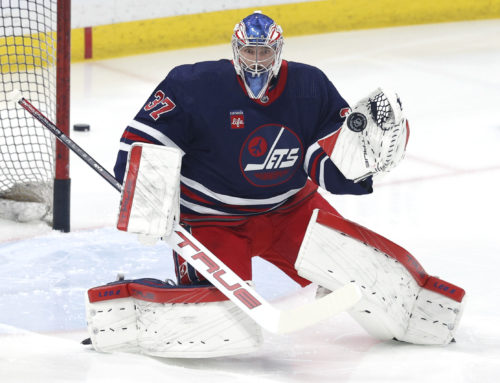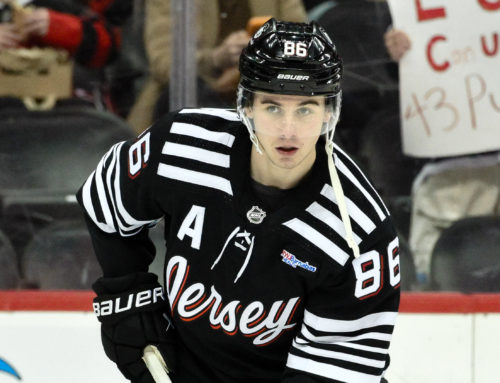Top 10 Players with Low IPP
Tom Collins
2024-01-29
Now that we’re in the second half of the season, fantasy general managers are trying to figure out who can rebound from a poorer-than-expected first half.
There are many metrics you can use to determine this: ice time, linemates, shooting percentage, power-play usage, etc.
One other useful metric is individual points percentage (IPP). Basically, IPP is how often a player picks up a point on any goal that is scored when they are on the ice. If a team scores 100 goals when a player is on the ice, and the player picks up a point on 40 of them, their IPP is 40%. Depending on the player, this could be a low percentage.
Below are 10 players who have a lower IPP this season compared to previous years. This doesn’t mean these players will have a great second half. Just because someone has been struggling and has a low IPP doesn’t mean they will automatically turn around their season. Some players will struggle all season. Some get buried in the lineup with fewer minutes and little power-play time, and don’t get the opportunity to bounce back. However, if these players revert to their normal IPP, you can expect more production the rest of the way.
There were many preseason projections listing Kotkaniemi as a sleeper pick. His numbers have improved almost every season, and he was expected to center the second line alongside Andrei Svechnikov. But after a hot start, Kotkaniemi’s production just never materialized the rest of the way. Lately, you’re more likely to see him on the fourth line with Brendan Lemieux and Jesper Fast than in a top-six role. So far, he is picking up a point on 51.4% of the goals scored while he is on the ice, down from 69.4% and 69% the previous two seasons, marking the lowest of his career. His PPIPP (power-play individual points percentage) is only 20%, a significant drop from 68.8% last year.
9. Kaapo Kakko
He doesn’t get much power-play time and he did miss about 20 games due to injury, but even considering those two things, he’s had a disappointing season. He’s got two points in his last two games, which brings him up to six in 28 games this season. He has spent most of the season on a line with Mika Zibanejad and Chris Kreider. Despite that, his IPP is 42.9%, a drop from last year’s 60.6%. He also hasn’t picked up a point with the man advantage, giving him a PPIPP of 0, down from 42.9% last year.
I’m a Habs fan, but I have never been a fan of Josh Anderson. There are a lot of people who fall in love with his size and speed, but he’s never been a big producer. Still, this year’s pace of 24 points is too low considering he’s been at exactly 38 points in each of his previous three campaigns. His low shooting percentage is playing a role in that as well. This year, Anderson has an IPP of 36.1%. It's the third-straight year he has seen a drop in IPP. Last year, he was at 51.6%, the year before at 59.3% and the season before that, he was at 70.6%. Anderson is a streaky goal scorer, so don’t be surprised to see him go on a crazy streak at some point, bringing that IPP back up.
Wennberg never lived up to the promise of his 59-point campaign back in 2016-17, and never cracked even 40 points again. His 33-point pace this season isn’t far off from his 38-point pace of the previous two campaigns, but he is still getting some opportunity. He’s averaging 18:26 minutes per night and gets consistent minutes on the second power-play unit. Going into Sunday's night game, his IPP is only 40.8%, down from 49.4% a year ago and 59.7% the previous year. His PPIPP is also down, but more significantly. It's at 21.4%, half of the 42.9% from a year ago. I’m not expecting him to go crazy, but if his IPP can get back up to normal, he could flirt with 45-50 points.
I see some fantasy general managers express their frustration with Drouin, especially after the game last week where Mikko Rantanen and Nathan MacKinnon had five points apiece, and Drouin had one. Drouin is on the top line at even strength and the top power-play unit, so he has a lot going for him. Part of the problem could be with MacKinnon, Rantanen and Makar out there at the same time, Drouin doesn’t touch the puck enough to pick up points. Right now, Drouin’s IPP is 40.6%. His career low is 59%, and he spent three of four years with the Habs north of 70%. His PPIPP is at 34.4%, down from 69.2% a year ago, and only the third time in his career he’s been below 64%.
5. Drew Doughty
From 2015-16 to 2022-23, Doughty had an IPP ranging from 44.1% to 51.7%. This year, he’s at 38%. One of the big reasons is his decrease in power-play IPP, where he’s gone from 92.9% two years ago to 69.2% last year to 47.8% this season. Doughty is already on his way back, with points in six of his last seven games. He's still averaging 26 minutes per contest and is on the power-play for 63.7% of the Kings’ power-play minutes.
Morrissey is one of those players that you can really only look at his past two years for IPP. Before that, he and Neal Pionk took turns being the Jets’ top offensive defenseman. Last year, Morrissey had an IPP of 58% and a PPIPP of 66.7%. This year, those numbers have dropped to 46.6% and 47.1%. That PPIPP is the lowest of his career, but he’s averaging a career high in shots per game and ice time. He only has four points in his last 13 games but should be due for a rebound.
Toffoli has an IPP of 48.6%. To get an idea of how low that is, last year with the Flames, he had an IPP of 70.2%. Even in Montreal, he was routinely around 65%. The lowest of his career is 56.7%, and every other year he’s been at 61%. On the power play, his IPP is even worse. He’s at a 29% PPIPP this year, down from 65.8% last year and marking the worst of his career. His next two lowest years are 33.3% in 2018-19 and 44% in 2015-16. Every other year has been at least 50%. After putting up 73 points last year, he’s on pace for 59 this season.
How bad has Montour’s IPP been? He’s been on the ice for 48 Florida goals this year, but has only picked up 11 points so far. That’s an IPP of 22.9%. He had an IPP of 47.7% a year ago. It’s the first time since 2019-20 he’s been below 41.9%. His PPIPP of 31.8% this year is also a significant decrease from last year’s 60%, and the only time in his career he’s been below 50%. Montour is still being used in an offensive role, is on the top power-play unit and starting in the offensive zone on 55.6% of his shifts.
1. John Tavares
The 33-year-old Tavares has been around a point-per-game player for almost his entire career. However, this year, he’s hovering around 0.74 points per game. That’s a 61-point pace, which is not ideal. He remains a mainstay on the second line alongside William Nylander and is also on the top power-play unit, but he’s just not getting the points. His IPP is 55.6%, one of the highest on this list, but far below last year’s 70.2%, and below his previous low of 62.5%. His PPIPP is at 40.7%, a significant drop from last year’s 72.2%. The Leafs still have a top-10 power play, Tavares just isn’t getting the points there.





 BUF
BUF N.J
N.J PHI
PHI MIN
MIN VAN
VAN FLA
FLA TOR
TOR CGY
CGY MTL
MTL